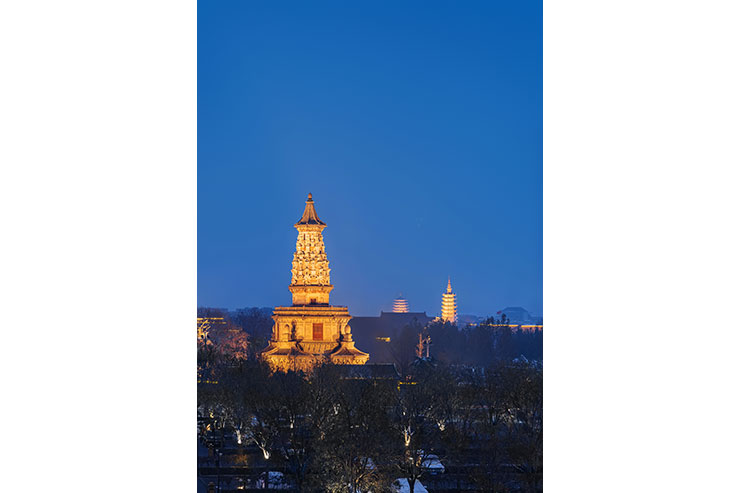- ABOUT
- JUDGING
- CONTACT
- MORE
- 2024 Entries
- Installations 2024
- Past Winners
- Subscribe
- [d]arc directory
- arc magazine
- darc magazine
Shijiazhuang Zhengding Ancient City, China
ProjectShijiazhuang Zhengding Ancient CityLocationShijiazhuang, ChinaLighting DesignBeijing Tsinghua Tongheng Planning and Design Institute, ChinaClientZhengding County Urban Management Comprehensive Administrative Law Enforcement BureauLighting SuppliersGuangzhou Yajiang Photoelectric Equipment
Zhengding Ancient City is a nationally renowned historical and cultural city with a history spanning over 1600 years, occupying an area of approximately 9,000 square meters. Three intact city walls to the east, south, and west, each standing at approximately 12 meters high and stretching about 6 kilometers, contribute to the city’s breathtaking grandeur. Within the city, a spectacular array of historical treasures awaits, including significant Sui Dynasty steles, Tang Dynasty wooden structures, well-preserved Song Dynasty architectural complexes, distinctive Tang and Song pagodas, as well as ancient structures from the Yuan, Ming, and Qing dynasties. Esteemed by the architectural community as a “treasury of ancient architectural art” and praised for its continuity through “nine dynasties.”
This is a living ancient city, with nearly 30,000 people still residing within its walls. Urban managers have dedicated almost a decade to the continuous operation of nighttime tourism in this ancient city. On November 5, 2021, the Ministry of Culture and Tourism designated the ancient city district as the first batch of national-level night cultural and tourism consumption gathering areas. The goal is to enhance the tourism value of the ancient city while ensuring its preservation. In response to a commission from the Zhengding Municipal Urban Management Bureau, the design team undertook the planning and design work for the nighttime illumination of the ancient city.
Design Strategy One: Illuminate the ancient city’s ceremonial aspects with light. Along a central axis, the southern city gate and Yanghe Tower shine brightest, portraying historical gateways and gathering spaces. The brightness gradually decreases for streets, walls, and towers. Corner towers, city walls, and ancient towers face each other, with the ancient towers bathed in a warm yellow glow to evoke a historical ambiance. Residential areas and the spaces beneath the eaves of streets around ancient towers are illuminated by 10W, 60° angle lamps, highlighting facades and ground without creating overly stark contrasts in the darkness. This ensures a clearer view when observing ancient towers and city walls at night.
Design Strategy Two: Conservation strategy – Respect for artistic and historical building protection.
“All parts with artistic and historical value should be protected: respect for cultural heritage buildings should include respect for the environment of cultural heritage buildings – Italian Charter of Cultural Heritage Protection.”
As historical relics not open at night cannot have lighting fixtures installed on building facades, a protective lighting design approach is adopted. All lighting fixture locations and electrical supports are entirely separated from the cultural heritage scope. New structures, such as building roofs or column light groups, are erected on the periphery to ensure no safety hazards within the cultural heritage boundaries. Lighting uses a distant projection method to showcase the uneven structure of ancient towers and the three-dimensional feel of brick surfaces, creating a captivating interplay of light and shadow.
For the South City Gate tower, open for night tours, fixture installation locations consider pole projection. Site surveys indicate pole distances mostly ranging from 75 to 85 meters. If floodlights are used, the minimum angle fixtures would simultaneously illuminate tile surfaces and red lighting, making it difficult to convey complete architectural colors. To address this, the design team employs traditional stage projection lights, projecting customized light patterns based on the building structure for precision. For instance, at a distance of 75 meters from the north facade of the city gate tower, 12 custom floodlights with a 35° tilted projection angle are used. To create architectural depth, 5 cut-off lights illuminate the top level tile surface, with a brightness of 8.8cd/m2; 3 cut-off lights illuminate the red facade, with a brightness of 1.8cd/m2; and 4 cut-off lights illuminate the bottom level tile surface, with a brightness of 8cd/m2. This ensures the best viewing conditions for tourists overlooking the four towers of Zhengding from the South City Gate.
Design Strategy Three: Use lighting to showcase the stories of the city’s history. At 7:30 p.m., large-scale performances featuring classic scenes from “Dream of the Red Chamber,” a concert at Yanghe Tower by renowned artists, and traditional Hanfu costume experiences attract visitors, injecting richer commercial vitality into the ancient city. A harmonious blend of the new and old, elegance and commonality unfolds.
The design team has developed a smart lighting control platform for the entire ancient city, enabling data-driven analysis, ensuring lighting safety and configurable scenes. It integrates low-power consumption strategies and addresses the requirements of digital information management and operation.
The participants of this project are Rong Haiyan, Yan Yunlei, Jiang Xue, Chen Yangyang, Sun Tian, Zhou Lili, Dong Li, Cai Huanzhen, Zheng Chonggang, Hou Mengqi.







